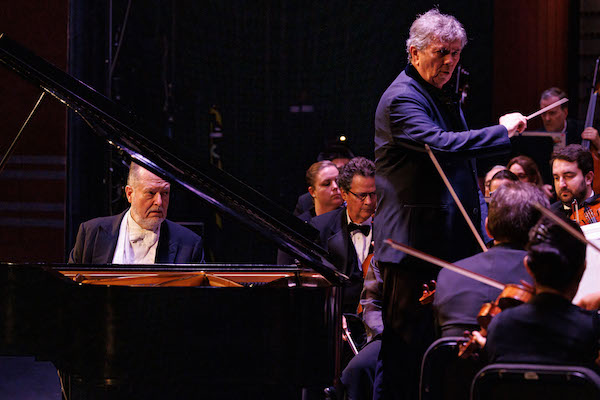Schwarz, Palm Beach Symphony deliver French showpiece and Finnish rarity

Garrick Ohlsson performed Beethoven’s Piano Concerto No. 5 with Gerard Schwarz and the Palm Beach Symphony Thursday night at the Kravis Center in West Palm Beach. Photo: IndieHouse Films
Sibelius’ most famous works, such as the Violin Concerto, Symphony No. 2 and Finlandia, have achieved such familiarity that it’s easy to forget the composer’s stark Nordic originality.
Then comes a weird piece like Night Ride and Sunrise, performed Thursday by the Palm Beach Symphony, and it hits home with particular force. Conductor Gerard Schwarz deserves credit for programming this neglected tone poem. Before raising his baton, he asked members of the orchestra on the Kravis Center stage for a show of hands on who had played it before. No hands went up.
Sibelius had given varying accounts of the work’s inspiration, once saying it was prompted by a visit to the Coliseum in Rome and another time attributing its origin to a sunrise during a sleigh ride from Helsinki to the town of Kerava. From the galloping style of the music, the sleigh ride inspiration seems more plausible.
For minute after minute, strings played repeated tense repeated figures that appeared to capture the sound of horses pulling a sleigh. The bleakness of the snowy nighttime landscape came through in the appearance of occasional bursts of brass or a fragment of woodwind melody, signs of life on an otherwise dark countryside.
Strings played with great precision and discipline in the repeated figures that formed the grid of the opening measures, as well as the dark brawny melody that emerged later. Brass played with quiet warmth and power in the ascending figures that appeared to symbolize the rising sun. While the work may not have the melodic inspiration or dramatic punch of Sibelius’ more popular compositions, it effectively conveyed a vision of a world that’s remote from most of us.
The great American pianist Garrick Ohlsson took the stage for Beethoven’s Piano Concerto No. 5, known as the “Emperor” concerto. At 74, the tall, physically imposing pianist retains a formidable technique, playing with seemingly effortless precision, accuracy and control, no matter how fast and thick the notes came.
His performance was more classically proportioned and precise than big and brawny. There wasn’t much fortissimo in this account of one of Beethoven’s most heroic works. He played the opening flourishes in a manner that emphasized fluid elegance more than extroverted grandiosity, and that’s how it went through most of the piece. In one long passage, where figurations in the piano accompany a melody in the orchestra, he was almost inaudible.
But Ohlsson also displayed a deft and sensitive touch with the concerto’s melodies. He played with pointed precision in the minor-key theme of the first movement and with frictionless fluency in the Adagio, bringing out the movement’s singing quality while leaning hard into the tension that preceded the sunburst of the concluding Rondo.
As an encore, Ohlsson played Chopin’s Waltz in C-sharp Minor, his liquid tone and sensitive phrasing bringing out the work’s autumnal melancholy.
The concert ended with a magnificent performance of Saint-Saëns’ Symphony No. 3, known as the “Organ Symphony” for the prominent role played by that instrument. A Palm Beach Symphony premiere, the symphony is a real showpiece, and the orchestra rose to the occasion.
Strings played with a luminous glow in the opening Adagio. Schwarz led a carefully calibrated buildup in the opening minutes as rustling strings were joined by woodwinds and brass to a furious climax. In the ensuing dark melody, horns and trumpets played with baleful luster.
The electronic organ on stage may not have had the depth, resonance and incisiveness of a real pipe organ. But as played by Doug Marshall, its throbbing chords gave warmth and richness to the moonlit melodies of the orchestra.
Strings brought aggressive bite to the opening notes of the Allegro Moderato, with the orchestra as a whole playing with such muscular compactness that the movement had the clipped, gruff quality of Beethoven.
Throughout the second half of the symphony—which is in two movements but seven tempo markings—Saint-Saëns gave the strings a real workout, from intricate high passages to glowering low ones, with fugal passages and other tests of clarity, and the string delivered a fine performance.
The Palm Beach Symphony’s next concert will take place 8 p.m. Jan. 30 and features Shostakovich’s Symphony No. 10 and mezzo-soprano Susan Graham in works of Debussy, Mozart, Lehar, Berlioz and Gershwin and Rodgers. palmbeachsymphony.org
Posted in Performances
Leave a Comment
Fri Dec 2, 2022
at 1:18 pm
No Comments